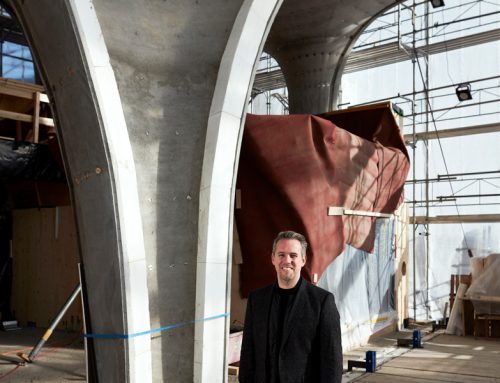On South Africa’s southern Cape coast we find Blombos Cave. No ordinary cave, it is one of the cornerstones in the detective puzzle of modern human thinking.
She walks along the shoreline collecting small shells and humming ‘she sells sea shells by the seashore’. Every couple of paces she stops, picks up a shell, examines it and either pockets it or casts it to the tides. The shells she selects are all of a similar size to make the necklace she’s planned.
Her family, gathered around their umbrella for the day at their Southern Cape seaside getaway, recedes into the smoky distance as she pursues her shell hunt, footprints pulsing and pulling in the wet beach sand.
By the time she returns, the wind, sand and sea have already covered her tracks. Just as they covered the tracks of all those who came before her, doing exactly what she is doing, collecting shells.
“That’s nice, you’re making a necklace” the girl’s mother smiles. Tens of thousands of years more significant than ‘nice’, it is one of the first acts of self-concept that defines modern human thinking.
Across the millennia, we developed the desire to adorn ourselves with something that will protect us, make us desirable and equip us for the life hereafter. Jewels, beads, shells, these are our ancient symbols of spirituality, status and identity, inherited from our deeply veiled past.
Take a walk with me now beside the Indian Ocean and into this deeply veiled past. Together we will retrace the steps of the girl collecting seashells by the seashore, for, on this same shore, 25 kilometres east of the village of Still Bay, a human being walked the same beach 75 000 years ago. She (or perhaps it was ‘he’) was carrying a handful of shells back to the family cave to make a necklace.
The family cave, situated one hundred metres from the ocean in a wave-cut cliff, is now known as Blombos Cave. No ordinary cave, it is one of the cornerstones in the detective puzzle of modern human thinking. A puzzle that includes shell necklaces, bone tools and engraved pieces of ochre, for these are the world’s greatest ‘modern human thinking’ clues. These are expressions of symbolic thinking that indicate the birth of a concept of self.
We reach Blombos Cave where we are welcomed by Professor of Archaeology, Christopher Henshilwood from the University of the Witwatersrand’s Institute for Human Evolution.
From 1991, Henshilwood led the excavations at Blombos Cave, which changed the world. Before Blombos, modern human culture was thought to have developed in Europe some 40 000 years ago, but here was evidence of it flourishing over 75 000 years ago – almost twice as long ago as had previously been believed.
Henshilwood leads us inside this archaeological wonder where the finds include the oldest known bone tools in the world, the largest collection of the earliest known beads (60 deliberately perforated shell beads, known as ‘tick’ shells from the Nassarius kraussianus mollusc) and two pieces of engraved red ochre consisting of scored lines forming a cross-hatched pattern.
“The tools, shells and engraved ochre were buried in a layer of sediment deposited during the Middle Stone Age and dated at 75 000 years via various luminescence techniques,” Henshilwood explains. “We’ve been exceptionally fortunate at Blombos because the generally alkaline environment is conducive to the preservation of bone and shell, especially near hearths and ash deposits.
“What made these shells unique is that 88% of them were dorsally perforated near the lip, which indicates deliberate piercing. Microscopic analysis further revealed a use-wear pattern absent in natural shells and consistent with friction from rubbing against thread, clothes or other beads.”
Equally revealing were the two pieces of red ochre, both unequivocally engraved. “Under magnification the crosshatched lines were verified as having been engraved with a stone point,” continues Henshilwood. “The effort required to produce these markings clearly suggests an intentional act, rather than doodling.
“The images clearly symbolise something. What this something might be is lost to antiquity because we don’t understand human thought that deep in time. However, the abstract geometrical patterns convincingly suggest that these are works of art: the oldest in the world.”
What this means is that the many priceless examples of art and adornment through the ages all date back to two pieces of engraved ochre and a shell necklace. These are the first symbols through which we began to examine life and our environment. These are the symbols through which we continue to understand life and our environment for they represent the most profoundly human characteristic: our awareness of life and death.
Prior to Blombos, the earliest forms of symbolic expression were widely thought to be cave paintings in southern France and northern Spain, dated at 35 000 years. Then came Blombos and the world shifted its thinking brain to southern Africa where Homo sapiens were showing signs of modern human behaviour 75 000 years ago.
Jewellery, personal adornment and art were clearly at the birth of this modernity, which triggered the development of self-concept and syntactical language that evolved into culture. ‘I think therefore I make a shell necklace’ could be the modern human motto.
Hand in hand with self-concept and language came a sense of life and death. Instead of simply abandoning our dead relatives, we started burying them in graves with flowers, beads and red ochre. This strongly indicates that we began to conceive of an afterlife. At the same time we started to believe in magic and that spirits, both good and evil, governed our lives.
We hung trinkets that we believed possessed magical powers round our necks, we put protection amulets in our earlobes, lips, noses and arms. We covered our bodies with red ochre and painted our dead relatives with the same. It had to be red, for red symbolizes blood and blood is the liquid of life, fertility and death.
In southern Africa, red ochre was widely mined, one important site being the Lebombo Mountains in Swaziland. Red ochre mines were in operation here from 80 000 years ago. It is hardly surprising that an ancient human burial site was discovered in the Lebombo Mountains. Here lay a small boy, buried with a seashell pendant and covered in red ochre.
The use of red ochre in burial is remarkably evident all over the world and across the millennia. At La Chapelle-aux-Saints in southern France, a man buried 45 000 years ago was packed in red ochre. In Wales, the ‘Red Lady of Paviland’ was buried in red ochre about 20 000 years ago. Australian aboriginal burials reveal the use of red ochre and Native American Indians used it for life and death rituals.
While the evidence of symbolic thinking abounds, the question as to precisely what happened to the pathways of the brain that got us thinking about ourselves, remains unanswered.
“The best and most likely interpretation is that the growth of human symbolic thought was a slow process that continued throughout the Middle Stone Age in Africa,” Henshilwood explains as we leave Blombos Cave. “The question as to how that flourishing of creative thought left Africa after this is still under discussion,” he smiles and we head back down the beach.




